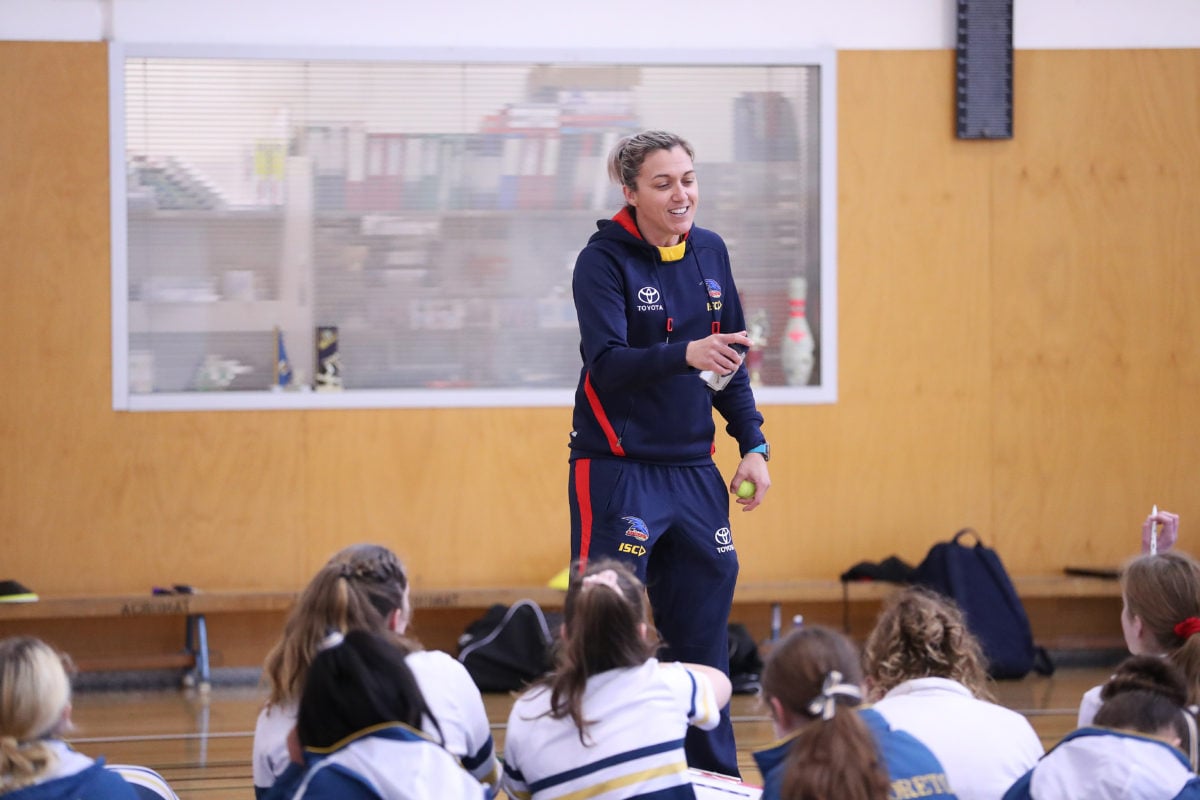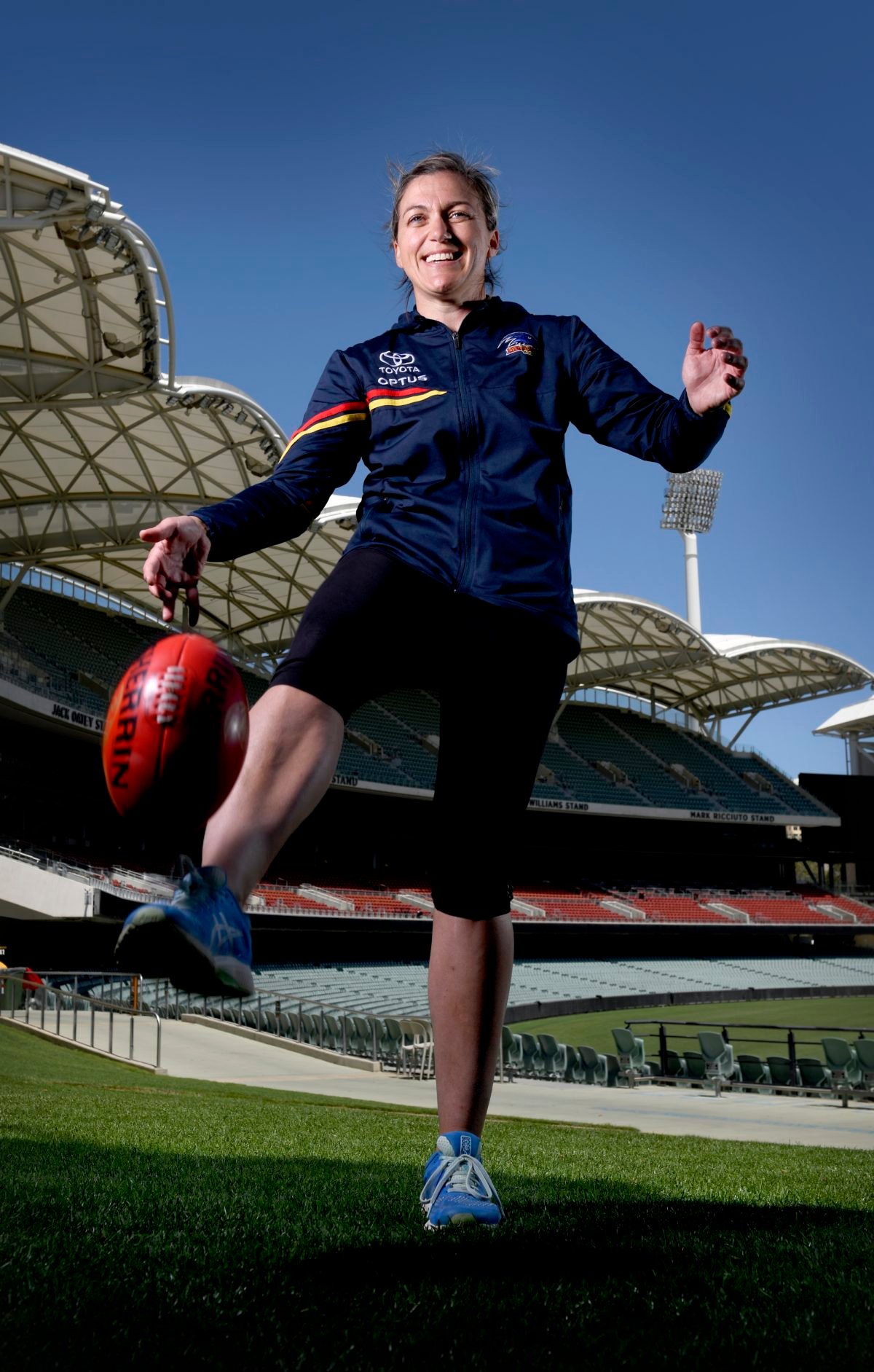Posted 10 Mar

Words by Sarah Keenihan.
Run! Kick! Calculate!
Imagine you create a new way to help children understand science and maths. The approach involves a professional Australian Football League (AFL) club, and gets kids outside doing activities like kicking goals from ridiculous angles, measuring heart-rate and reacting to a flashing light as fast as possible.
Fun, right? But the question teachers and policy-makers will want to know is whether it’s better for education. And what does “better” even mean in a classroom? It’s complicated.
Over 2018-2020 former teacher Katie Gloede worked with US sports science expert Ricardo Valerdi and the Crows football club to develop a program called STEMfooty – with STEM referring to science, technology, engineering and maths. To look at whether STEMfooty improves learning and teaching in schools, she’s now doing her Doctorate in Education (EdD) with UniSA Education Futures.

A different way to learn
Katie’s motivation in creating STEMfooty comes from her belief in the power of hands-on education – something referred to as kinaesthetic learning.
“As one example, the Australian curriculum, or ACARA, says children in year 7 maths need to know obtuse, acute and reflex angles,” Katie explains.
“So if we take them out onto a football field and ask them to kick goals from these angles, often this can create a visual memory that is really useful for them.”
With a straight reference line drawn across the base of the two goal posts, an obtuse angle kick – more than 90° but less than 180° – could take place roughly in front of the goals, say a few steps to the left of centre. This is relatively simple.
The acute kick of less than 90° is harder, often requiring setup in what’s called “the pocket” – the small area at a tight angle at either side of the goal (adjacent to the boundary line). The kicker only has a narrow view of the goal width from this spot.
Finally, the real challenge is in the kick from a reflex angle, where the angle is more than 180°. To achieve this one, you have to walk off the oval and into the seating area behind the goals – now kick it to curve around the short posts and pass through the tall posts on the oval side. Nearly impossible.

Whether the children are good kickers or not doesn’t really matter. The point is that the activity is memorable, and real.
“In STEMfooty, we combine the physical activities with normal classroom lessons, and activity books,” Katie said.
“And what we hope is together these different kinds of learning will help embed the maths concepts for the children.”
What will success look like?
It’s not enough that STEMfooty is easy for teachers to use, and that students enjoy it – although these are both clearly true from trials so far in Adelaide schools.
The program needs to be evaluated scientifically, which is where Katie’s EdD studies come in.
Two key questions are whether STEMfooty improves how children feel about STEM and how good they are at doing STEM. In teaching terms, these are referred to as children’s attitude towards and aptitude for STEM. These are tricky to measure, but fortunately Katie has a questionnaire ready to use thanks to her US collaborator.
“I’m going to measure attitude and aptitude, including children’s views about careers in STEM, both before and after they’ve been exposed to one term of STEMfooty at school,” Katie said.
“I’m also going to analyse the impact in boys and girls at single sex versus co-educational schools.”
For STEMfooty to be successful would be reflected in data showing it results in children enjoying and doing better at STEM, but also planning to continue with STEM subjects as their school years progress and having an idea of what STEM careers might look like.
Katie will also measure how well the STEMfooty course matches up with the Australian STEM curriculum, and interview teachers and parents to collect data about their experiences of the program.
Why do we need STEMfooty?
Data over the past 20 years or so consistently show fewer and fewer school children continuing with subjects like advanced maths.
And even though girls and boys have similar abilities in STEM subjects, females tend to drop out of the maths and sciences at a faster rate than boys. Katie is particularly interested in addressing this fall in female students.
“And while many teachers would love to be able to do more STEM, they’re so time poor they aren’t really able to dedicate hours to working out how to integrate it more fully,” Katie suggests.
“So much of what children are normally doing has science and maths in it, it’s just a matter of making those connections and helping teachers incorporate it into the classroom.”
Who knows, STEMfooty might help find a few new superstars for future AFL teams as well.
